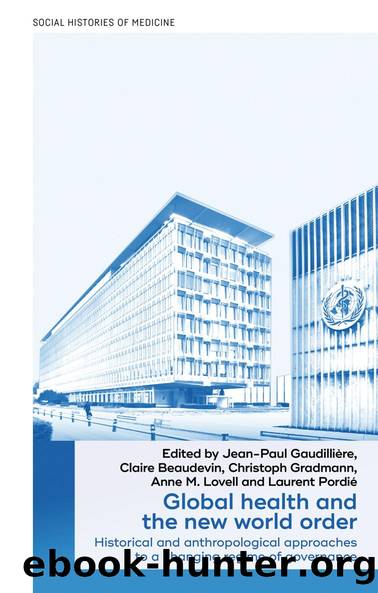Global health and the new world order by unknow

Author:unknow
Language: eng
Format: epub
Tags: Nonfiction, History, Modern, 20th Century, Health & Well Being, Medical, Social & Cultural Studies, Social Science
ISBN: 9781526149664
Publisher: Manchester University Press
Published: 2020-10-06T04:00:00+00:00
6
You've got the point? Acupuncture and the techno-politics of bodyscape
Wen-Hua Kuo
Learn the rules like a pro, so you can break them like an artist. (Attributed to Pablo Picasso)
Introduction: global acupuncture and bodies on treatment
Acupuncture is an essential part of East Asian medicine. A peculiar way of diagnosing and treating people via meridians inside their bodies punctuated by regulatory points, it is a simple yet sophisticated art of healing that has been used for thousands of years. To appreciate acupuncture, beginning acupuncturists have to start with the rules, meaning they need to memorize the names and locations of acupuncture points and the meridians to which they belong before practising acupuncture on the human body. As in any bodily therapeutics, skills involving placing needles and manipulating them emerge as a passage toward de qi (bring about the desired sensation), the transcendental harmony between the healer and the healed.
After circulating in East Asia for more than 1,000 years, acupuncture was introduced into Europe in the late seventeenth century as an oriental way of healing, and some personal efforts to promote this art were made in the early twentieth century (Candelise, 2008; Lu and Needham, 2002). Even so, it was US President Richard Nixon's historic visit to China in 1971 that opened up not only the communist People's Republic of China (PRC) but also â via acupuncture â the treasure box of traditional Chinese medicine (TCM).1 The interest in acupuncture also led to an influx of TCM physicians into the US during the turmoil of the Chinese Cultural Revolution.
Acupuncture also influenced public health at the global level. Following its recognition of traditional medicine in 1979 by listing 208 medicinal herbs as essential to a country's public health, the WHO went on to proclaim that acupuncture should be taken seriously as a treatment of significant value. In addition to some instances of medical aid that incorporate TCM or other East Asian medicines, a twenty-first-century example of using acupuncturists to facilitate global health can be best demonstrated by the non-profit organization Barefoot Acupuncturists, which was founded by Belgian acupuncturist Walter Fischer in 2009. Inspired by the PRC's barefoot doctor movement in the 1960s and 1970s, this organization aims to provide efficient and affordable care with acupuncture in Mumbai and has treated more than 4,500 patients in India.2
Meanwhile, acupuncture attracts biomedical scrutiny through its global spread. Such efforts date back to early encounters between East and West, as seen in an introductory paper in The Lancet in 1823 (Lock, Last and Dunea, 2001: 9). However, serious appraisal of its use in pain control did not appear until the late 1940s. George Soulie de Morant (1879â1955), a long devotee of acupuncture in France, published LâAcuponcture Chinoise (1951), which was widely used by his European followers, including: Eric H. Wilhelm Stiefvater, the author of Akupunktural und Neuraltherapie (1956); Paul Nogier, the reviver of auriculotherapy; and Reinhold Voll, the inventor of Elektroakupunkturnach Voll. Compared to other traditional clinical practices in East Asia, such as herbal formulas and massage, acupuncture is uniquely Asian, yet rational to the rest of the world.
Download
This site does not store any files on its server. We only index and link to content provided by other sites. Please contact the content providers to delete copyright contents if any and email us, we'll remove relevant links or contents immediately.
International Integration of the Brazilian Economy by Elias C. Grivoyannis(90815)
The Radium Girls by Kate Moore(11921)
Turbulence by E. J. Noyes(7935)
Nudge - Improving Decisions about Health, Wealth, and Happiness by Thaler Sunstein(7615)
The Black Swan by Nassim Nicholas Taleb(7010)
Rich Dad Poor Dad by Robert T. Kiyosaki(6399)
Pioneering Portfolio Management by David F. Swensen(6226)
Man-made Catastrophes and Risk Information Concealment by Dmitry Chernov & Didier Sornette(5921)
Zero to One by Peter Thiel(5685)
Secrecy World by Jake Bernstein(4643)
Millionaire: The Philanderer, Gambler, and Duelist Who Invented Modern Finance by Janet Gleeson(4374)
The Age of Surveillance Capitalism by Shoshana Zuboff(4209)
Skin in the Game by Nassim Nicholas Taleb(4161)
Bullshit Jobs by David Graeber(4094)
The Money Culture by Michael Lewis(4076)
Skin in the Game: Hidden Asymmetries in Daily Life by Nassim Nicholas Taleb(3929)
The Dhandho Investor by Mohnish Pabrai(3698)
The Wisdom of Finance by Mihir Desai(3650)
Blockchain Basics by Daniel Drescher(3506)
